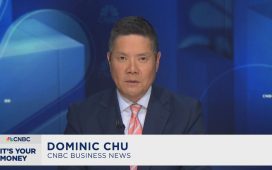Aerial view of illuminated skyscrapers standing at the Pudong Lujiazui Financial District at night on June 10, 2022 in Shanghai, China.
Vcg | Visual China Group | Getty Images
This report is from today’s CNBC Daily Open, our new, international markets newsletter. CNBC Daily Open brings investors up to speed on everything they need to know, no matter where they are. Like what you see? You can subscribe here.
What you need to know today
Asia-Pacific markets climb as U.S. snapped 3-day losing streak
Asia-Pacific markets rose on Tuesday, tracking moves on Wall Street as U.S. markets snapped a three-day losing streak. Markets cheered China’s move to extend outstanding loans to ease pressure on the property sector, in what is seen as Beijing taking more concrete steps to support sagging growth in its economy. Technology counters outperformed for a second session, relieved that China’s probe on the sector is over for now.
India woes
Apple supplier and global manufacturing powerhouse Foxconn has pulled out of a $19.5 billion joint venture project with Indian conglomerate Vedanta that would have brought semiconductor and display manufacturing to the Indian state of Gujarat.
More tech job cuts
Microsoft confirmed Monday that it’s eliminating additional jobs, a week after the start of its 2024 fiscal year. The cuts are in addition to the downsizing announced in January that resulted in 10,000 layoffs.
What is China’s new foreign relations law about?
Geopolitics hold more sway than new Chinese laws for foreign businesses in China. National security is a growing priority for the country. Two new laws, one on espionage and the other on foreign relations, took effect July 1. They contain catch-all phrases such as “state secrets” that are open to interpretation by local and central authorities.
[PRO] Goldman names under-the-radar global stocks to buy — and says one could soar 80%
Goldman listed a raft of “out-of-consensus buy ideas” for investors to consider. The bank is at least 2% above consensus on each stock in terms of 2023-2024 earnings per share, and said that less than 50% of other analysts are buy-rated on its picks.
The bottom line
One’s judiciously deciding how to ease, another’s trying to time its next tightening move.
The United States and China, the world’s largest economies, are on divergent monetary policy paths that are spelling some headaches.
China’s inflation data released Monday was yet another sign that its post-“zero Covid” recovery has basically stalled. Producer prices in June fell 5.4% year-on-year, the ninth consecutive drop and sharpest decline since December 2015. Consumer prices were unchanged compared with a year ago. Both figures were worse than predicted — economists had expected PPI to drop 5% and CPI to increase 0.2%.
Resuscitation is needed to reflate the economy, China’s teetering on deflation.
Beijing has so far cut rates in June and pledged “targeted and coordinated policy, which would be implemented in a timely manner.” Late Monday, authorities said they told lenders to extend outstanding loans to ease pressure on the property sector. The Chinese real estate sector heaves a sigh of relief, perhaps not so much Chinese banks.
On the other side of the Atlantic, market watchers are intently watching U.S. inflation data due later this week. Will these offer more signs that the Fed will hike rates?
U.S. inflation cooled in May to rise 4%, its lowest annual rate in more than two years, but core inflation rose by 0.4% month-on-month and 5.3% year-on-year.
Central banks are at “the end of the beginning” in their battle against inflation, as several factors keep core prices persistently high, according to top Societe Generale economist Kokou Agbo-Bloua.
The persistence of labor market tightness and the apparent resilience of the economy means the market is pricing around a more than 90% chance that the Fed will hike rates to a range of between 5.25% and 5.5% at its meeting later this month, according to CME Group’s FedWatch tool.
Complicating the macro watch for everybody, Nomura said other central banks in Asia could start cutting rates even earlier than the Fed.
It seems that 2% is everybody’s magic inflation number. Hang in there for the ride, we are still a long way from that.












